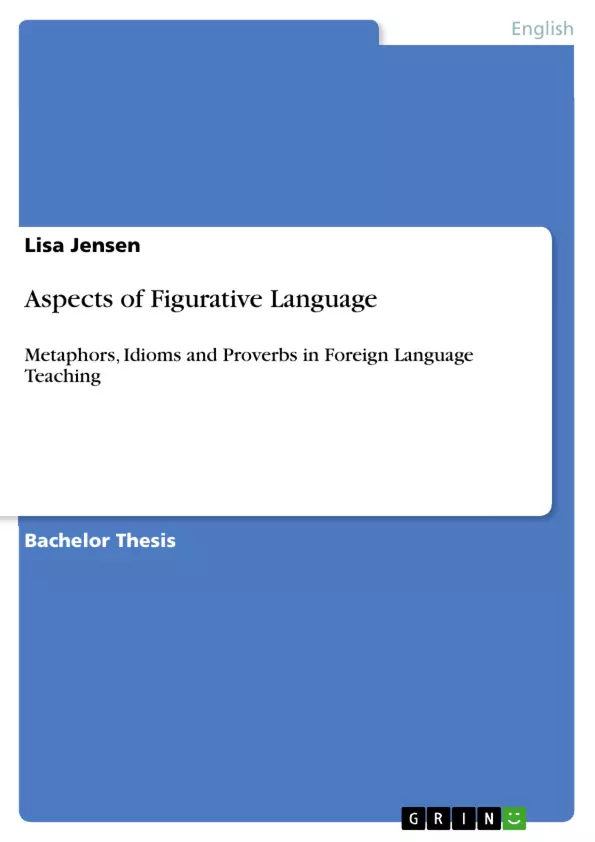The paper deals with different types of figurative language and the question of why and how these should be taught in second language teaching. In order to prove that figurative language is essential in communication and therefore needs to receive more attention in schools, I start by analysing and comparing the concepts of metaphors, idioms and proverbs.
Many scholars have discussed metaphors and so as to outline the most important aspects, I refer to Lakoff, Johnson, Ortony and Langlotz amongst others. Those aspects will include the differences between novel and conventional metaphors, the different functions that metaphors fulfil and the phenomenon of mixed metaphors.
When discussing idioms I focus on their relationship to metaphorical language, the aspect of frozenness and their functions as well as other topics. Here, scholars like Swinney, Skandara and Götz are quoted and their propositions towards idiomatic language are analysed.
To end the first part of the paper I discuss the relationship of proverbs to metaphors and idioms and base this part on Norrick in order to focus on didactic content and the issue of distinguishing between a proverb's literal and figurative meaning.
After having given the survey of those concepts, I turn to the part of explaining why it is so important to teach figurative language and I do that by drawing on Ortony's theses of compactness, inexpressibility and vividness. Furthermore, Katz's theory of metaphor as politeness is examined and also Liu's view on idioms as containing cultural references.
To end this theoretical paper with an idea of how to use the information practically, the last section deals with the question of how figurative language is best taught. The methods presented are based on a preceding part of background information on how the comprehension process of figurative language works and what the prerequisites are for being able to learn that part of a foreign language. This last part of the paper is mainly based on Ortony, Gentner, Liu and Ur.
Eventually, I conclude the paper by summing up the findings and evaluating their relevance for teaching figurative language in second language learning in schools.
Table of Contents
- Introduction
- Survey
- Metaphors
- Mapping of Metaphors
- Metaphors as Experiences
- Creation of Similarities
- Metaphors vs. Similes
- Novel vs. Conventional Metaphors
- Dead vs. Alive Metaphors
- Emotive Function
- Expressing Humour
- Idioms
- Frozenness
- Simply Phrasal Metaphors?
- Functions of Idioms
- Types of Idioms
- Defining Idioms
- Proverbs
- Didactic Content
- Fixedness
- Why Teach Figurative Language?
- Ortony's Theses
- Politeness
- Social Competence
- Didactic Content
- Cultural Values
- Near-native Speech
- How to Teach Figurative Language
- Teaching Strategies
- Metaphors
- Idioms
- Proverbs
Objectives and Key Themes
This paper aims to demonstrate the importance of figurative language in English as a Foreign Language (EFL) learning and teaching. It argues that figurative language, including metaphors, idioms, and proverbs, is essential for effective communication and understanding of English, and therefore should be given more attention in EFL teaching.
- The role of figurative language in communication and understanding English.
- The characteristics and functions of metaphors, idioms, and proverbs.
- The pedagogical implications of teaching figurative language to EFL learners.
- Strategies for teaching metaphors, idioms, and proverbs in EFL classes.
- The importance of understanding cultural values and near-native speech.
Chapter Summaries
Chapter two provides a comprehensive survey of the concepts of metaphor, idiom, and proverb, exploring their defining characteristics and classifications. It analyzes the different types of metaphors, including novel and conventional metaphors, and discusses the role of idioms in communication. It also delves into the concept of proverbs, highlighting their didactic content and fixedness.
Chapter three explores the reasons for the importance of teaching figurative language in EFL classes. It examines Ortony's theses on the compactness, inexpressibility, and vividness of figurative language, and discusses the role of politeness, social competence, and didactic content in language acquisition. It also highlights the importance of enabling learners to achieve near-native speech.
Chapter four focuses on practical strategies for teaching figurative language to EFL learners. It examines the prerequisites necessary for students to be ready to learn figurative language and outlines important aspects to be taught. It presents hands-on tasks for teaching metaphors, idioms, and proverbs, drawing on existing research and pedagogical practices.
Keywords
The key concepts and focus areas of this work include figurative language, metaphor, idiom, proverb, EFL (English as a Foreign Language) teaching, communication, cultural values, near-native speech, pedagogical strategies, and language acquisition.
- Citar trabajo
- Lisa Jensen (Autor), 2010, Aspects of Figurative Language, Múnich, GRIN Verlag, https://www.grin.com/document/181179



